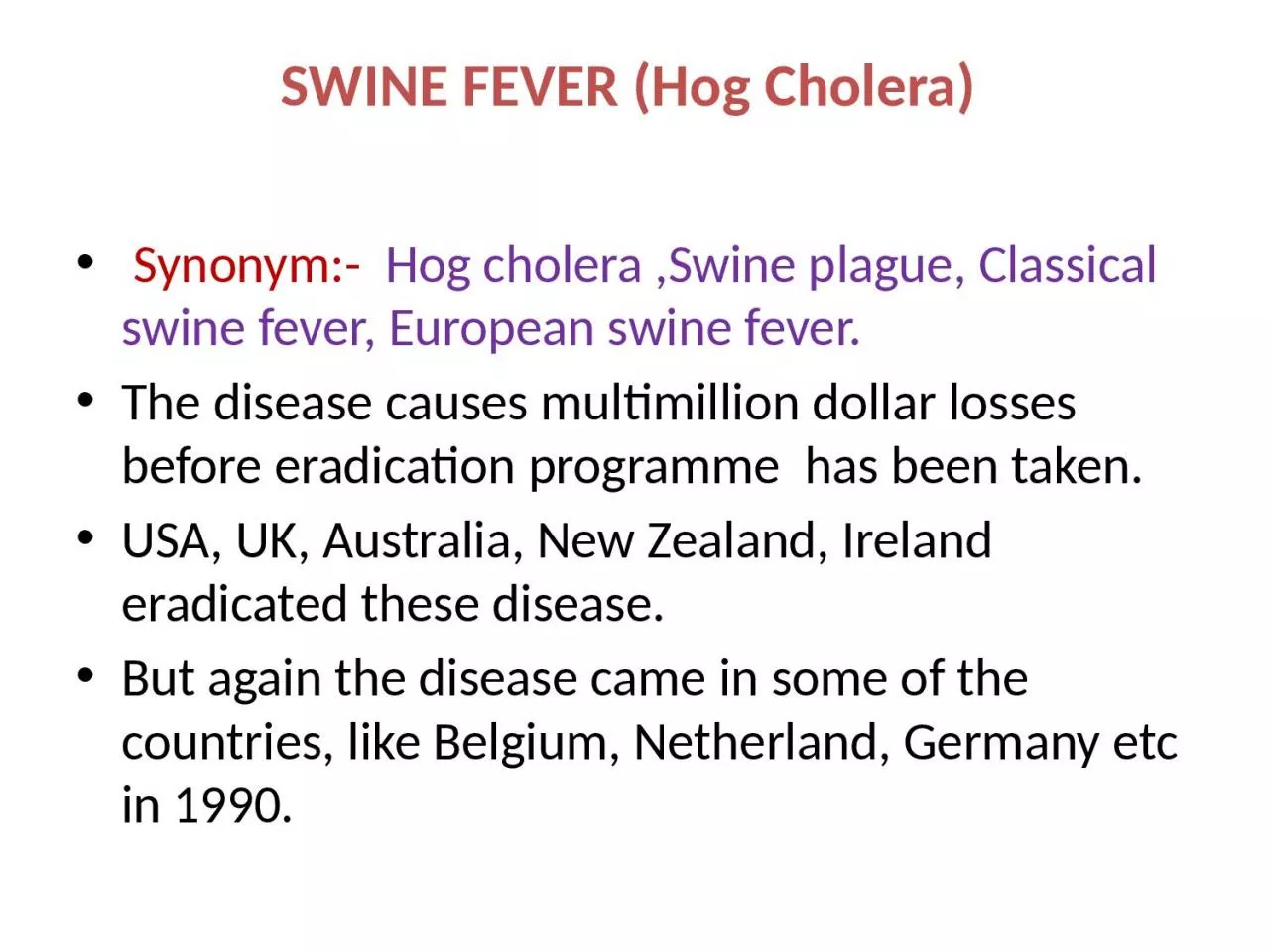

Synonym Hog cholera Swine plague Classical swine fever European swine fever The disease causes multimillion dollar losses before eradication programme has been taken USA UK Australia New Zealand Ireland eradicated these disease ID: 917955
Download Presentation The PPT/PDF document "SWINE FEVER (Hog Cholera)" is the property of its rightful owner. Permission is granted to download and print the materials on this web site for personal, non-commercial use only, and to display it on your personal computer provided you do not modify the materials and that you retain all copyright notices contained in the materials. By downloading content from our website, you accept the terms of this agreement.
Slide1
SWINE FEVER (Hog Cholera)
Synonym:-
Hog cholera ,Swine plague, Classical swine fever, European swine fever.
The disease causes multimillion dollar losses before eradication programme has been taken.
USA, UK, Australia, New Zealand, Ireland eradicated these disease.
But again the disease came in some of the countries, like Belgium, Netherland, Germany etc in 1990.
Slide22Swine fever is an acute contagious viral disease of pigs caused by
pestivirus
and characterized by gluing of eyes, button ulcers in intestine, congestion and
haemorrhage in visceral organs.
SWINE FEVER (Hog Cholera)
Slide3Etiology
Pestivirus
of
Togaviridae familyRNA virusThe virus of Hog cholera and Mucosal disease are antigenically similar.
Slide4Incubation period 1 to 4 days by artificial infection and 7 days in natural infection
Slide5IncidenceFirst recognized in 1885 in the United States, its viral aetiology was established in 1903
The disease is seen worldwide including India
Susceptibility
The pig is the only domestic animal which is naturally infected by the virus
Slide6Transmission
The infection is usually acquired by ingestion, but inhalation is also a possible route
Routes of infection
Digestive tractRespiratory tractConjunctivaNasal mucosa
Slide7PathogenesisThe first virus enters into blood after multiplication in tonsillar tissue
After that the virus will infect the lymphoid organs
and also infect liver, spleen and other internal organs.
There is leukopaenia, thrombocytosis.
Slide8Sing & Symptoms The virus has special affinity for the endothelial cells of blood vessels &
reticulo
-endothelial system.
The vascular endothelial cells swell, proliferate and occlude the lumen.The wall of blood vessels undergo hyaline degeneration with infiltration by lymphocytes, macrophages and plasma cells.These changes of blood vessels are the cause of hemorrhages, necrosis and infarection found in various organs.
Slide9Spleen – severally infarcts are wedge shaped, found on the edges of the orgen & are browinesh
in color.
Lungs –
croupous pneumonia.In the Intestine – especially in the cecum and colon, are found the characteristic “Button shaped ulcer”.Kidney – found petechiae on the cortex extending deeply into the parenchyma. These gives a characteristic “
Turkey egg appearance”.
Slide10Skin – shows erythematous patches which become cyanotic. Later vesicles may form on the lips, vulva & edges of ears.Brain – non – purulent
meningo
– encephalomyelitis.
“Perivascular cuffing” - i.e – accumulation of lymphocytes, monocyes, plasma cells & local histocytes in the
perivascular space – ( Robin Virchow).
Slide11Sing & Symptoms In mixed infections – Salmonella cholerae suis
often complicates the picture.
The original name of the disease “Hog Cholera” was derived from the discovery.
Slide12Clinical Signs
Acute disease
Huddling, dullness
High fever (105
oF)AnorexiaErythema, cyanosisPetechiaeStaggering, weakness
ConvulsionsPoor reproductiveperformance
Abortions, stillbirths
Deformities
Slide13Post Mortem Lesions
Highly variable
Acute infection
Hemorrhage
Necrotic foci in tonsilsPetechiaeKidney, larynx, trachea,intestines, spleen, lungs
Slide14Post-Mortem Lesions
Chronic infection
Necrotic foci
Intestinal mucosa(‘button’ ulcers)EpiglottisLarynxCongenital infectionCerebellar hypoplasia, thymic
atrophy, deformities of head and legs
Photo courtesy of Dr. R. Panciera, Oklahoma State University
Slide15Differential Diagnosis
Diagnosis is impossible without lab testing
Porcine reproductive and respiratory syndrome (PRRS)
Porcine circovirus associated diseaseSalmonellosisErysipelasLeptospirosisAujeszky’s
disease (pseudorabies)African swine feverTonsil samples should be sent with every submission to your state diagnostic lab
Slide16Sampling
If Classical Swine Fever is suspected:
The proper animal health authorities should be contacted, before collecting or sending any samples,
Samples should only be sentunder secure conditions, to authorized laboratories to prevent spread of the disease
Slide17Diagnosis
Laboratory Tests
Detect virus, antigens, nucleic acids
Tissue samples (tonsils, spleen, kidneys, distal ileum)Whole bloodELISA or direct immunofluorescence SerologyELISA or virus neutralizationComparative neutralization testDefinitive test
Slide18Disease Control
Disinfectants
Sodium hypochlorite
Phenolic compoundsVirus sensitive toDryingUltraviolet lightpH of less than 3 or greater than 11
Killed at high temperatures 150oF for 30 minutes; 160oF 1 minute